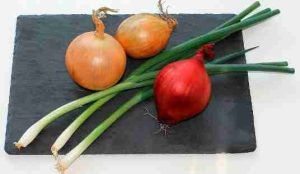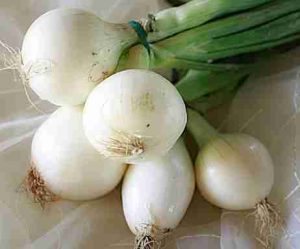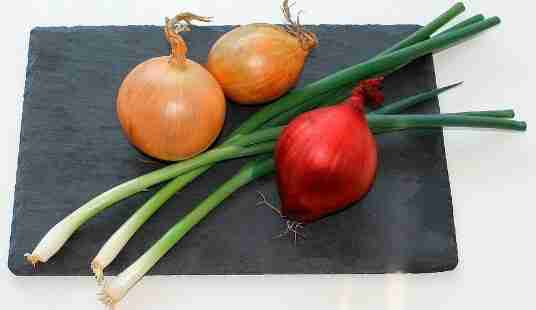Is onion a nightshade vegetable?
 No, onions are not nightshade vegetables.
No, onions are not nightshade vegetables.
Nightshade vegetables belong to the Solanaceae family. It includes plants like tomatoes, potatoes, eggplants, and peppers (bell peppers, chili peppers).
But, Onions, belong to the Allium genus and are related to garlic, leeks, and chives.
Onions and nightshade vegetables are commonly used in cooking, and they are very delicious foods in cooking.
Onions are widely used in culinary preparations around the world for their distinct flavor and versatility.
They come in various types, such as red onions, yellow onions, and white onions, each with its own flavor profile and culinary uses.
Onions are known for their pungent aroma and taste, which can vary from mild and sweet to sharp and spicy, depending on the variety and how they are prepared.
In addition to their culinary uses, onions have been valued historically for their medicinal properties.
They contain chemical compounds that are believed to have health benefits, such as antioxidants and anti-inflammatory properties.
Onions are also a good source of vitamins and minerals, including vitamin C, vitamin B6, and potassium.
Onions are often used as a base ingredient in many dishes, providing a savory foundation of flavor.
They can be sautéed, caramelized, roasted, or even eaten raw, depending on the desired taste and texture.
Their versatility makes them a staple in kitchens worldwide, whether used in soups, stews, sauces, salads, or as a topping for burgers and sandwiches.
Different types of onions can be selected based on their flavor profiles and how they complement your dishes.
Here are some common types of Onions:-
- Yellow Onions
- Red Onions
- White Onions
- Shallots
- Green Onions (Scallions)
- Spring Onions
- Sweet Onions
- Leeks
- Cipollini Onions
- Pearl Onions
- Bermuda Onions
- Onion Chives
Onion powder
Onion powder is a dehydrated, ground form of onions. It’s made by drying fresh onions and then grinding them into a fine powder. It’s commonly used in cooking to add onion flavor without the bulk or texture of fresh onions. It blends well in sauces, soups, marinades, and dry rubs, providing a concentrated onion flavor. It’s also convenient for dishes where you want the flavor of onion without the visible presence of onion pieces.
Nutritional Value of Onion
 Onion is a nutritious vegetable that is rich in various vitamins, minerals, and other nutrients. It is used as an important ingredient in food.
Onion is a nutritious vegetable that is rich in various vitamins, minerals, and other nutrients. It is used as an important ingredient in food.
Here are the nutritional facts of onion (Per 100g of Onion):
Energy: About 40 calories
Water: 89%
Protein: 1.1 grams
Fat: 0.1 gm
Carbohydrates: 9.3 grams
Fiber: 1.7 grams
Sugar: 4.7 grams
Vitamins and Minerals
Vitamin C: about 8 mg
Vitamin B6: about 0.1 mg
Folate: about 19 micrograms
Potassium: about 140 mg
Calcium: about 27 mg
Iron: about 0.2 mg
Onion Nutrition and Health Benefits Regular inclusion of onion in daily diet can be beneficial for your health.
Onions Health Benefits
Onion (Allium cepa) is a type of vegetable that is used to enhance flavor in cooking. But the benefits of onion are not limited to the flavor of cooking.
Its nutritional value and health benefits are quite extensive.
Below are some important benefits of onion:
Increase the body’s immunity
Onions are rich in vitamin C, which helps strengthen the body’s immune system. It protects the body from various viruses and bacteria.
Reduces the risk of heart disease
Onions contain antioxidants and anti-inflammatory properties, which help lower blood pressure and reduce the risk of heart disease. In particular, onion contains cuquercetin, which improves blood circulation and helps maintain heart health.
Helpful in controlling diabetes
Chromium content present in onions helps in improving insulin function and keeps blood glucose levels under control.
Improves digestive health
Onions contain fiber which is helpful in maintaining the health of the digestive system. It helps in relieving constipation and stomach problems.
Anti-bacterial and anti-fungal properties
Onion has anti-bacterial and anti-fungal properties, which help prevent various types of infections.
Beneficial for skin
Vitamin C in onions helps improve skin health. It helps keep the skin bright and smooth and can reduce acne problems.
Anti-oxidant properties
Antioxidants such as quercetin and sulfur compounds present in onions help eliminate free radicals from the body, which helps reduce the risk of cancer and other long-term diseases.
Weight loss aid
Since onions are low in calories and high in fiber, they can help in weight loss. It helps to maintain the feeling of fullness for a long time.
Onions can be included in your daily diet to ensure these benefits, but should be consumed in proper amounts and as part of a balanced diet.
Onion vs shallot
Onions and shallots are both members of the allium family, which also includes garlic, leeks, and chives.
Here are some key differences between them:
Appearance and Size
Onion: Typically larger in size, with a more rounded shape and multiple layers of flesh covered by a papery skin.
Shallot: Generally smaller and elongated compared to onions, with a shape resembling a garlic bulb. They usually have multiple cloves (like garlic) covered in a thin, coppery or reddish-brown skin.
Flavor
Onion: Can range from mild and sweet to pungent and sharp, depending on the variety.
Shallot: Mild and sweet with a hint of garlic flavor. Shallots are often preferred in dishes where a more subtle onion flavor is desired.
Usage
Onion: Used in a wide variety of culinary applications, including raw in salads, cooked in soups, stews, and sauces, and caramelized for a sweet flavor.
Shallot:Commonly used in French and Asian cuisines for their delicate flavor. They are excellent when finely chopped and added raw to salads, dressings, or used in sauces and vinaigrettes.
Cooking Characteristics
Onion: Can withstand longer cooking times and higher temperatures without losing their texture or flavor.
Shallot: More delicate and can burn easily if cooked at too high a temperature or for too long. They are often added towards the end of cooking to preserve their subtle flavor.
Cultural Use
Onion: Widely used globally in various cuisines.
Shallot: Particularly favored in French and Southeast Asian cuisines for their distinct flavor.
While both onions and shallots belong to the same family and share some similarities, such as their culinary versatility, they differ in size, flavor profile, and best culinary uses.
Shallots are often prized for their milder, more nuanced flavor compared to onions.
Onion recipes
Onion chutney
Onion chutney is a delicious condiment made primarily from onions, often complemented with spices, herbs, and sometimes other ingredients like tomatoes or tamarind.
It’s a popular side dish in South Indian cuisine, typically served with dishes like dosa, idli, or even with chapati or rice.
Here’s a simple recipe to make onion chutney:
Ingredients:
2 large onions, thinly sliced
2-3 dried red chilies (adjust according to spice preference)
1 tablespoon urad dal (split black gram)
1 tablespoon chana dal (split chickpeas)
1/2 teaspoon mustard seeds
1/2 teaspoon cumin seeds
A pinch of asafoetida (hing)
Few curry leaves
1 tablespoon oil
Salt to taste
1 tablespoon tamarind pulp (optional, for tanginess)
1 teaspoon jaggery or sugar (optional, for slight sweetness)
Preparation:
Heat oil in a pan over medium heat.
Add mustard seeds and let them crackle.
Add cumin seeds, urad dal, and chana dal. Sauté until they turn golden brown.
Add dried red chilies, curry leaves, and asafoetida. Sauté for another minute.
Cooking:
Add sliced onions and cook until they turn translucent and lightly browned. Stir occasionally to prevent burning.
If using tamarind pulp, add it now for a tangy flavor. Also, add salt to taste.
Cook everything together for about 5-7 minutes until the onions are caramelized and soft. Turn off the heat and let it cool.
Blending:
Once cooled, transfer the mixture to a blender or food processor.
Blend to a smooth or coarse paste, depending on your preference. Some like it finely ground, while others prefer a slightly coarse texture.
Finishing:
Taste and adjust salt if needed.
If you prefer a touch of sweetness, you can add a teaspoon of jaggery or sugar and blend again briefly.
Serving:-
Transfer the chutney to a serving bowl.
Serve it as a side dish with dosa, idli, chapati, rice, or any dish of your choice.
Onion jam
Onion jam is a sweet and savory condiment made from onions, sugar, vinegar, and sometimes other spices or seasonings.
It’s cooked down until the onions caramelize and the mixture thickens into a jam-like consistency.
Ingredients:
4 large onions, thinly sliced
1/4 cup olive oil or butter
1/2 cup brown sugar
1/2 cup apple cider vinegar
1/2 teaspoon salt
Optional: herbs like thyme or rosemary, spices like black pepper or cloves
Instructions:
Caramelize the Onions: Heat olive oil or butter in a large skillet over medium-low heat. Add the thinly sliced onions and cook them slowly, stirring occasionally, until they become golden brown and caramelized. This process can take about 30-40 minutes.
Add Sugar and Vinegar: Once the onions are caramelized, stir in the brown sugar, apple cider vinegar, salt, and any optional herbs or spices you’re using. Increase the heat to medium and cook, stirring frequently, until the mixture thickens and becomes jam-like. This usually takes another 10-15 minutes.
Cool and Store: Remove the skillet from heat and let the onion jam cool to room temperature. Transfer it to clean, sterilized jars and store in the refrigerator. It will keep for several weeks.
Serving Suggestions:
Cheese Platters: Serve alongside cheese and crackers.
Sandwiches: Spread on sandwiches or burgers for added flavor.
Meat Dishes: Use as a topping for grilled meats like chicken.
Appetizers: Use as a topping for crostini or bruschetta.
Onion jam adds a delicious sweet-savory element to dishes and is versatile enough to complement a wide range of foods.
Onion soup
Let’s discuss a recipe for French Onion Soup –
Ingredients:
4 large onions, thinly sliced (yellow or white onions work well)
4 tablespoons butter
2 tablespoons olive oil
2 cloves garlic, minced
1 teaspoon granulated sugar (helps with caramelization)
1/2 cup dry white wine (optional, but recommended)
6 cups beef broth (or vegetable broth for a vegetarian version)
2 bay leaves
1 teaspoon dried thyme (or 2-3 sprigs of fresh thyme)
Salt and pepper, to taste
Baguette slices, toasted
Gruyère cheese, grated (or Swiss cheese)
Fresh parsley, chopped (for garnish)
Instructions:
Caramelize the Onions:
In a large pot or Dutch oven, melt the butter and olive oil over medium heat.
Add the sliced onions and cook slowly, stirring occasionally, until they are soft and caramelized to a deep golden brown color. This process can take about 30-40 minutes. Stir in the minced garlic and sugar during the last 10 minutes of caramelization to enhance flavor.
Deglaze the Pot:
If using wine, pour it into the pot and stir, scraping up any browned bits from the bottom. Let it cook for a few minutes until most of the wine has evaporated.
Simmer the Soup:
Add the beef broth, bay leaves, and thyme to the pot. Bring the soup to a simmer.
Let it simmer for about 20-30 minutes to allow the flavors to meld together. Season with salt and pepper to taste.
Broil the Soup:
Place the bowls on a baking sheet and put them under the broiler until the cheese is melted, bubbly, and lightly browned.
Garnish and Enjoy:
Carefully remove the bowls from the oven using oven mitts.
Garnish with chopped fresh parsley if desired, and serve immediately while hot.
This French Onion Soup is rich, comforting, and perfect for a cozy meal. Enjoy it.
Onion bhaji
Making delicious onion bhajis at home:
Ingredients:
2 large onions, thinly sliced
1 cup chickpea flour (besan)
2 tablespoons rice flour (optional, for extra crispiness)
1 teaspoon cumin seeds
1 teaspoon coriander powder
1/2 teaspoon turmeric powder
1/2 teaspoon red chili powder (adjust to taste)
1/2 teaspoon baking powder
Salt to taste
Water, as needed (about 1/2 to 3/4 cup)
Oil for deep frying
Instructions:
Prepare the Onions: Peel and thinly slice the onions. Separate the slices into individual pieces.
Make the Batter: In a mixing bowl, combine chickpea flour (besan), rice flour (if using), cumin seeds, coriander powder, turmeric powder, red chili powder, baking powder, and salt.
Gradually add water to the dry ingredients, whisking continuously, until you get a smooth batter. The batter should be thick enough to coat the onion slices well. It should not be too runny.
Mix and Coat: Add the sliced onions to the batter. Mix well, ensuring all the onion slices are coated evenly with the batter.
Heat Oil: Heat oil in a deep frying pan or kadhai over medium-high heat. The oil should be hot enough for frying (around 350°F or 180°C).
Fry the Bhajis: Take small portions of the onion mixture using your fingers or a spoon and carefully drop them into the hot oil. Do not overcrowd the pan; fry in batches if necessary.
Fry the bhajis for 3-4 minutes, turning occasionally, until they are golden brown and crispy on all sides.
Drain and Serve: Once done, use a slotted spoon to remove the bhajis from the oil. Drain excess oil on paper towels.
Serve hot onion bhajis with your favorite chutney, yogurt dip, or enjoy them plain as a snack or appetizer.
